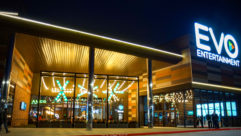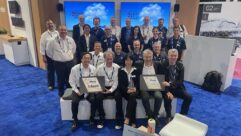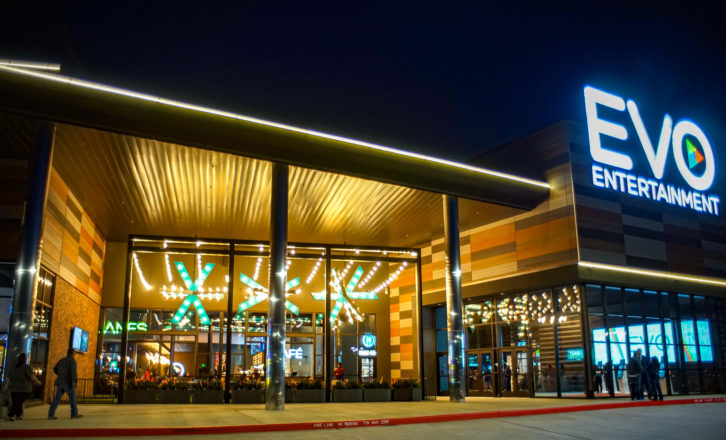 On this edition of the SVC Podcast, Contributing Editor Bennett Liles completes his interview with Andrew Adams and Eric Ramay of AV design and installation firm Mood:Texas. In Part 2 they discuss the installation of projectors, meeting room AV, control systems and crew training in the new EVO Entertainment Multiplex in Schertz, Texas.
On this edition of the SVC Podcast, Contributing Editor Bennett Liles completes his interview with Andrew Adams and Eric Ramay of AV design and installation firm Mood:Texas. In Part 2 they discuss the installation of projectors, meeting room AV, control systems and crew training in the new EVO Entertainment Multiplex in Schertz, Texas.
FOR MORE: GO TO PART 1
- SunBright 75-inch Signature Series outdoor displays
- NEC PA Series 4K UHD Laser Projector
- RTI KX10 10-inch in-wall touchpanel keypads
- Mood Digital Signage
TRANSCRIPT:
In Schertz, Texas the new EVO Entertainment Multiplex surrounds visitors with lights, video and sound from every direction. Mood:Texas designed and installed this incredible system and Andrew Adams and Eric Ramay are back to finish up their story on how they got it all up and running. That’s right up ahead on the SVC Podcast.
Andrew and Eric, welcome back to Part 2 of the SVC Podcast from Mood: Texas in Austin. We were talking about the EVO Entertainment Multiplex in Schertz, Texas. You put in the control systems, the displays, the sound all on a strict timeline. In addition to the movie theaters and meeting spaces they’ve also got a huge bowling alley. There are a bunch of projectors in there so how do you use the projectors in the bowling alley?
Andrew: The bowling alley is a really unique space. We noticed at the existing EVO locations that the projectors that were there were really not impressive and it sort of took away from the experience. So we wanted to make sure and get this right on the new location. So our distributor, Almo, actually sent us a few different NEC models of projectors and we were able to go to that old location that somebody else installed and put those projectors on those screens to show Mitch (owner) the drastic difference between what they had before and what they could have at this location, and actually pick which model he thought looked best. The model he picked was an NEC 6500 lumen laser projector. We have eight of those pointed at 850 3-1/2-inch Draper fixed screens and they are seamless image-to-image. They are bright. I mean, they almost look like LED panels on the end of the lanes. Really impressive image, and each one of those has a Just Add Power receiver connected to it as a distribute source. And then we have another eight displays right above you when you’re bowling next to the bowling scoring screens showing mostly digital signage. I mean, those are also using Just Add Power receivers with the same distribution.
Eric: Yeah, and once again the NEC projectors are seamlessly put in there with the Just Add Power, so once again they’re sharing all the sources with all the other displays including the video wall above the bar. They have the access to all those sources – DVD player, satellite receivers – everything that everybody else has. Full on and off, and once again that’s all automated. They didn’t want somebody to have to go out there with a remote, walk down the lane and try to hit the IR bug. So once again, they come on at a certain time every morning and they shut off at a certain time at night. It makes efficient use of the projectors. And we also monitor the bulb life and everything like that to where we can actually fire off any kind of warnings as they get close to the end of life on those projectors, if there’s anything going on. [Timestamp: 2:50]

It would appear that it’s quite a bit safer to have the passive screens down there where there are bowling pins flying around than some very expensive electronic video displays.
Eric: Exactly. And sometimes they’re working down there and they can bump into those screens. I mean, we actually had one that somebody accidentally really bumped into but it was a simple matter of making sure it was level again. And the way the screens butt up, as Andrew brought out it looks like one continuous display. It’s very clean looking. And the width of those bezels on those screens is very thin so you do have a little bit of space to divide the picture instead of just having bleed-over, but on the other hand it’s really thin so it gives you just a very clean look on the end of those bowling lanes. [Timestamp: 3:31]
Yes, a lot going on in there sound-wise. It’s a very noisy environment. I noticed there are some speakers extended down from the ceiling.
Andrew: Yeah. So we went with those because they’re very directional. .And the reason why we went that route is because the sound is emanating from the lane coming back at the people bowling. We decided to do that so the experience is the same whether you’re going up and approaching the lane and it actually will give you that full-force audio has you’re bowling instead of having just speakers above the people sitting there. They wanted a full immersive experience; the music being part of it. And that included the Klipsch KI-262 speakers, facing them for the mids and highs. And then we of course had the 15-inch subwoofers for every four lanes. That’s covering some really deep lows. Once again that’s all adjustable to how deep they want the bass to go. [Timestamp: 4:19]
In an environment like this in many cases the trickiest part of it would not be the video but the sound, just keeping the sound isolated and localized.
Andrew: Right. And overcoming all of the difference in sound from an empty bowling lane to a full one is drastic. I mean, it’s a loud activity with people talking, yelling and then the pins and the balls themselves. So that bowling lane has the ability to get really loud and have some really high-quality audio. You could have a rager of a party in there.
Eric: And all that, like I said, is all easily controlled and it’s all limited and everything to where yeah, they can get it loud enough to hurt your eardrums but they can never blow up those speakers. And that’s all controlled from the – once again, putting the limits and everything in there to keep them within a certain range so we don’t get a call out there saying we have to replace multiple speakers. It keeps them to where they stay honest with the sound. [Timestamp: 5:13]
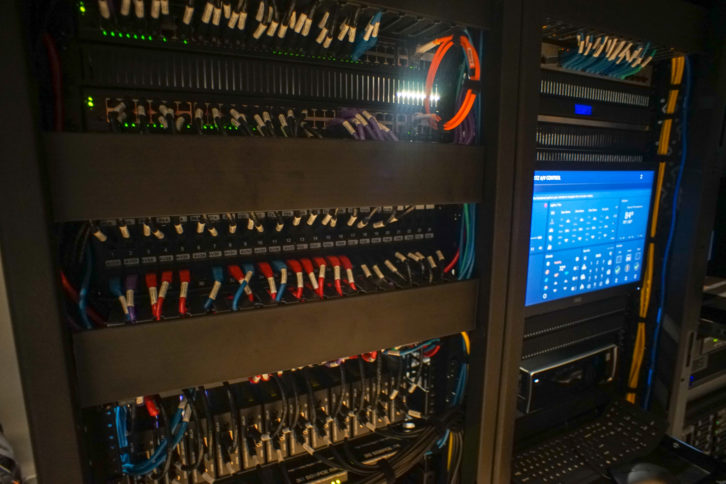
That long line of projectors coming down from the ceiling looks pretty cool anyway, just the visual effect of it. And how do you get the video distributed to those projectors?
Andrew: Still the Just Add Power system. The same system that we used for the video wall in the bar, the same one for the displays everywhere. There’s Just Add Power receivers at each of those projectors. It’s full 4K on that unit and once again it just shows whatever source they want and it’s easily addressable from a control pad. They can send any source to anywhere. Any display that has a Just Add Power device on it, they can send any of their sources to any of those displays. That’s the same for the NEC projectors. [Timestamp: 5:47]
That’s really great that you don’t have to put up with a lot of signal format conversions or anything like that.
Andrew: No, no, no. It’s very intuitive. And simplicity was key here and that’s what we have. [Timestamp: 5:57]
And if you want to take a break from the action you can go out on the patio. You’ve even got some things outside there. I think there are some Sunbright 75-inch monitors out there. How was it setting those up and doing sound for that area?
Andrew: It was fun for that one because we have the displays out there, and once again we had the Just Add Power system, and that was fairly simple that we hung the displays out there. But the cool thing we got to do is we had an array speaker up high that actually – one of the things they wanted was to be able to have the experience of when you’re walking up to be able to hear sound but we also have the challenge to not make it to where the people that are sitting on the patio were completely awash in, you know, holding their ears. So what we came up with was the array speakers, the JBL CBT 1000’s, so it’s able to send constant dB audio far out in the parking lot while still retaining a manageable level in the patio. Once again, from the control they can either send the music source out there, they can send their own auxiliary source out there, or they can actually just look at the display and they can play whatever is on the display. So they have a football game out there, they have this great speaker blasting audio for what’s going on on the football game right out there on the patio. It’s a great experience to step out there and watch a game.
Eric: Yeah, we’ve got about a 70-foot throw of even coverage from that one speaker. It’s pretty incredible. [Timestamp: 7:14]
Not only do you have bowling and all that action but there are also some event rooms. What’s in there for sound and video? I think you have the KX3 touch panels and those rooms can actually be combined into one bigger space.
Andrew: Yes. Exactly. So there’s KX3 touch panels in each of the event rooms and form those panels you can control that individual event room, audio, video, send your own source to the TV in that room only, play your own audio source in that room only. Or you can use those touch panels or the master iPad to combine the rooms to become one space, choose one dedicated source to play on all the screens in there or any combination you want. Overhead we have Klipsch IC-650 ceiling speakers. We used the Attero Tech POE Bluetooth and 3-1/2 millimeter audio input. Yeah, it’s been a really nice setup and we worked directly with the event coordinator, who is not AV savvy at all, and she’s able to set up all of her groups in any sort of format she wants. And because the system is expandable they actually added a new event room and were able to add some Just Add Power receivers, add the Attero Tech Bluetooth input, and voila, we have another event room because we set it all up to be expandable. [Timestamp: 8:27]
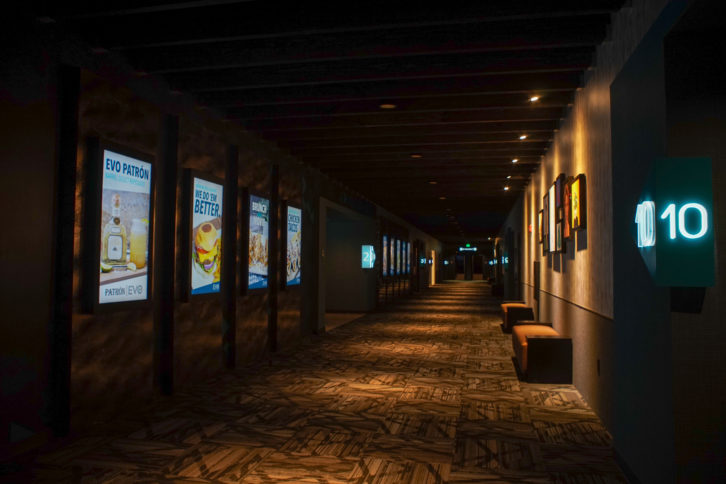
Yes, that was one of the more remarkable things about this is that whenever they want to expand you can expand.
Eric: Yeah, and that’s just it. That’s one reason we went into this deciding that everything is going to be standard network infrastructure. So once again, even the expansion in the room was going to be standard CAT-6, no real specialty cable for most of it. We do have some different cable to run the speakers off of, of course, but we’re not reinventing the wheel or getting real expensive cable out there. We’re doing standard category cable for all those units. [Timestamp: 8:55]
So this place had to open on time. What was your timeline on this project? Did you happen up on anything that proved to be a little more of a challenge than you expected?
Andrew: Yes. I’d say the biggest challenge was the fact that most construction sites in this field, they like to tell you when they’re going to open and sometimes that’s usually a figment of their imagination. But this one was dead on their schedule. So they had crews working overnight, they had crews working during the day. I’ve been in this business for 15 years on all aspects, including operations manager, and just trying to keep up with their construction process was – I’ve never seen a place get built that was this big this fast. So we had to be really on top of our game interfacing with the general contractor, interfacing with the owner, and making sure that we were right on the right timeline. And sometimes that timeline just took us by surprise because usually we would look at it and our experience would tell us that we’ve got about a month, but then they’d some back and tell us we’ve got a week and we would have to trust that because that’s what would happen. It would be done. And a big part of that was because they were racing a competitor that was probably about a half a mile away with a lot of the same systems. [Timestamp: 9:59]
A huge number of people and different trades to coordinate. You were in there working shoulder to shoulder with the rest of them and that’s got to be a big challenge not getting anybody too far behind or too far ahead.
Eric: Yeah. I’ve dealt with a lot of different construction projects and I’ve got to tell you, this one was like one big family. Everybody, even though we’re on top of each other during certain points there’s still people I email to this day working around the country. We got to know a lot of them very personally and once again everybody working with Robert Mitchell and his family, everybody felt like part of the family during this whole process. So it was actually, I have to say, the greatest experience I’ve had working with a construction site ever. The general contractor all the way down to the people that were over it, instead of having discussions that would turn into arguments that happen sometimes they were completely forthcoming, understood everything and made sure that all of our needs were met. And we tried our best to make sure all of their needs were met. So it was a great experience. [Timestamp: 10:56]
I think probably one of the big things on a system this widespread and complex is setting it all up to be easily operated. I think you’ve said that it had to be designed to be operated by teenagers.
Andrew: Yes. So we realized when we were designing this control system, like you said, a very complex system, that the people using it were going to be very young; often teenagers. Think of the people that work at movie theaters. And they’re curious. They want to play with the system. They want to change things. And so we had to make it bullet-proof. We had to make it so they couldn’t screw it up. They had to have all the functions make sense and be cohesive so that they could just scroll through and do everything they need to do. And we also put some backup so that if something did go wrong they could call us and we could remotely reset or just reset the system at any time. So we were a little worried about the end user on this really complex system. It’s worked out really well and a lot of times I show up and they do all the controls right there in front of me. I don’t even have to help. So I think we did a good job of allowing teenagers to operate this massive system.
Eric: And Andrew put up a good point. Part of this, too, is I can log in or one of our technicians can log in anywhere in the world using the RTI platform. We can fire off different commands just to see what’s happening or we can bring everything back. One time I got a call and they just – their screens weren’t on the right input. So it sounded like somebody was just flustered and I was able to just log in real quick, hit one button and put everything back to what their standard layout is just by being able to get on my computer and log into their system. Very simple, very easy to use, and also gives us the ability to make sure our customer is taken care of on the service side. It’s a lot easier to be able to log on remotely than have to send a tech out with all the time constraints that has. [Timestamp: 12:46]
Yeah, that’s a great way to have it set up. One phone call from anybody there and suddenly everything goes back right again.
Eric: Exactly. And it’s just like magic. We hit a button and they’re literally on the phone with us like oh, okay. That’s working. Okay, that’s working. Oh, we’re good. And that whole experience took them about five minutes to give us a phone call, open up my computer and it’s done. [Timestamp: 13:05]
A real task to make it all operate that easily but it does and now you can push on to other projects so what does Mood: Texas have coming up?
Eric: Well right now we’re continuing with the EVO family. So they like the system, they like working with us, so they have other facilities with older equipment there so we’re looking forward to bringing those facilities up to the same standard that this recent install was. We’re working with the same people. It’s going to be different this time because we’re going to be working on places that are already open and we’re going to not be doing the whole place from the ground up. But this still gives us the excitement of being able to carry over those controls and carry over a lot of the systems into the newer facilities. We just recently got done with a lot of stuff for Frost Bank, one of the biggest, well-known banks here in Texas, doing conference room systems. They have three conference rooms that were divisible and full VoIP integration so that was a really fun project. It’s a brand-new building in downtown San Antonio, beautiful building. It’s one of the highlights of the skyline of San Antonio now. We got to be in there and doing their system, so that one was another real exciting, and of course just looking down the road to furthering the conference room systems and continuing to work on making sure the technology meets the needs of our customers. [Timestamp: 14:21]
Well, this one was huge. I’m amazed when I see all of the images on this and think about getting all of this done on time. Great hearing the story on it. We’ve been talking with Andrew Adams and Eric Ramay from Mood: Texas about the huge new EVO Entertainment Multiplex in Schertz, Texas. Good luck and thanks for talking with us about it.
Eric: Thank you for having us.
Andrew: Thank you again, Bennett.
The new EVO Entertainment Multiplex is a real showcase of what’s possible with perfect AV setup and control by Mood:Texas. Get back with us next week for another AV installation and production project right here on the SVC Podcast. See you then.



